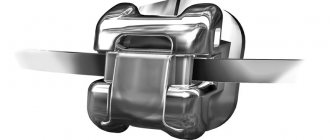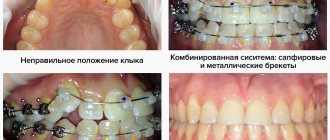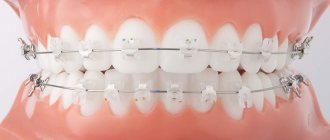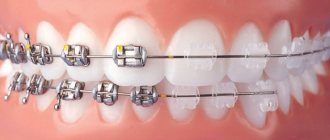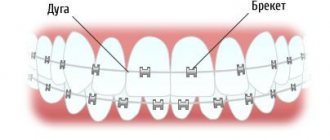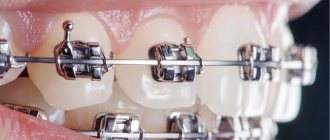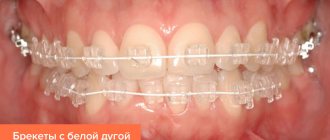Classic braces systems are fairly voluminous structures that provide gradual displacement of teeth in the required direction due to an arch firmly attached to the braces using elastic ligatures - rubber bands. But most patients are embarrassed by the lack of aesthetics of such systems, the discomfort that occurs when such a brace system is overloaded, as well as other difficulties that arise during dental care. Specialists in the field of aesthetic dentistry, creating new types of tools for straightening the bite, tried to take these points into account as much as possible, and thus self-adjusting braces came into the arsenal of orthodontists, differing from conventional ones in the absence of any additional mechanisms.
Such braces do not require conventional ligatures. The already outdated rubber bands have been replaced by reliable latches. At the same time, an overdose of forces is almost completely eliminated, since when overloaded, the clip seems to release the arc, allowing it to move without problems like sliding doors. This also allows you to correct your bite and significantly reduce treatment time. In addition, there is no need for regular visits to the orthodontist’s office, since there is no need to change an elastic ligature that is broken/damaged during use. Self-adjusting braces are examined by an orthodontist once every couple of months - this is enough for safe and correct treatment.
What are self-ligating braces?
For many years, classic ligature braces have been used to correct dental anomalies. They consisted of clasps glued to the teeth and a metal arch attached to them. The arch in such a system is attached to the clasps with ligatures - elastic rings or wire rings, and to the side teeth - with metal rings. The arch is fixed so that its traction helps straighten the teeth in the right direction. Ligature braces are still widely used today, but they require frequent visits to the doctor to correct the tension of the arch and change the ligatures (they quickly stretch and change color).
In the mid-90s of the last century, a new type of braces systems appeared - non-ligating or self-ligating. The difference between self-ligating braces and ligature braces is that instead of ligatures, they use special caps with clasps, through which an arch is threaded, like through channels. Getting rid of ligatures brought significant relief both to the orthodontist when installing braces and to the patient while wearing them. Currently, both ligature and non-ligature braces are used.
Differences between ligature and self-ligating braces
Metal self-adjusting braces
Non-ligature metal braces are the most popular and common type of non-ligature braces. Such metal braces have long proven their effectiveness and cope well even with complex cases. They are used in the correction process even in the most difficult cases.
Such metal bracket systems are characterized by the least aesthetics, but maximum efficiency. At the moment, even patients with allergies can afford metal braces - for them, companies make special systems cast from hypoallergenic materials.
Advantages and disadvantages of non-ligature systems
Self-ligating non-ligature braces have a number of advantages over classic ligature braces. They:
- thinner, more elegant, less noticeable;
- provide easier adaptation of the patient to them;
- are installed quickly, since there is no need to attach the arc separately to each lock, it is simply threaded through the caps;
- allow precise adjustment of the system taking into account the required trajectory;
- do not require frequent correction: you need to visit the orthodontist no more than once every two months, whereas after installing ligature braces - once a month or even more often;
- physiological, do not have a negative effect on periodontal tissues;
- reduce the duration of correction;
- do not require much maintenance effort compared to ligature ones (food debris gets stuck mainly in the ligatures).
The disadvantage of non-ligature self-ligating braces is their higher price compared to ligature ones.
Why patients love Damon technology so much
The stability of positive patient reviews is that:
- Damon braces are suitable even for those whose teeth are too small and whose gums are too low to receive conventional braces. This system is approved for use by almost all patients over 12 years of age, even if the mucous membrane of their mouth is highly sensitive. Sometimes, at the discretion of the orthodontist, Damon braces are installed on children over the age of 9 years.
- Installation does not require facial or palatal arches, expanders or other extraneous devices. This greatly simplifies and speeds up the orthodontist’s work process. In addition, an undesirable psychological factor is removed - after all, unnecessary devices cause anxiety, depression and even hypochondria for many.
- After installing Damon braces, the percentage of patients who complain of discomfort or pain is very low. Blood vessels are not compressed, blood circulation in the oral cavity is not impaired. For comparison, patients with conventional ligature braces have to put up with pain for several weeks; many are prescribed painkillers.
- A visit to the clinic should be scheduled on average once every 1.5 months, and, depending on the progress of treatment, this interval may increase to once every 3 months. This schedule is extremely convenient for both the patient and the orthodontist. For comparison: patients with ligature braces are required to visit the clinic strictly once a month.
- A visit to a specialist lasts on average 15 minutes, while patients with ligature braces have to spend an hour in the orthodontist’s office. Thanks for this we must say to the Spin Tek latch - its locks open so quickly that replacing the arc occurs in the shortest possible time.
Among the negative aspects of Damon technology, patients usually mention only the price. But, firstly, it fully justifies the quality of the service, and secondly, the brand’s assortment includes a large selection of both more budget and more premium systems, so customers are given a large choice.
ATTENTION:
Rumor has it that Damon's technology does not involve tooth extraction. Alas, this is a myth: if the client has severe crowding of teeth, then it will not be possible to do without extraction. Otherwise, there may be a risk of bone atrophy and other unpleasant consequences. However, you really have to resort to removal less often than when installing standard ligature models.
Types of self-ligating braces
Liature-free braces are divided into types according to their mechanism of action, material of manufacture and brands of individual manufacturers (brands).
By mechanism of action
Based on this feature, ligature-free braces are divided into two types:
- active – the cap (clip) exerts active pressure on the arc, forcing it to move in the desired direction;
- passive - the lid does not affect the arc in any way, it simply holds it in the lock; it is believed that this is a more natural type of correction that does not injure the periodontal tissues.
By material
Metal and ceramic self-ligating systems
Self-ligating braces are made from metal, dental ceramics and artificial sapphires. The strength and volume of the model, as well as indications for its use and aesthetics, depend on the material of manufacture.
Metal self-ligating braces
The most popular and reliable non-ligature models. Advantages:
- durable, reliable bracket systems, do not break, suitable for correcting any anomalies;
- easy to install and remove;
- cheaper than models made from other materials.
The disadvantages of metal structures include their low aesthetics: metal braces, even with the smallest locks, will always be visible when you smile.
Ceramic self-ligating braces
Also popular models are made of durable white dental ceramics in different shades. They are installed by patients who want to look more aesthetically pleasing. Advantages of metal self-ligating bracket systems:
- lighter and more comfortable to wear;
- you can choose the color of the locks exactly to match the color of your own teeth and they will be invisible, since they do not give glare;
- the adaptation period passes quickly, there is practically no discomfort or speech impairment;
- do not injure the soft tissues of the oral cavity.
Disadvantages of ceramic structures:
- more fragile compared to metal ones, sometimes they break and are not used for the correction of complex malocclusions;
- more expensive than metal ones;
- the metal arc is still visible when you smile.
Sapphire self-ligating braces
Made from transparent artificial sapphires, characterized by high strength and brilliance. Advantages:
- aesthetics - the reflection of light makes the metal arch less noticeable and gives the smile a radiance;
- stronger than ceramic ones, but inferior in strength to metal ones; therefore, they are used to correct some complex malocclusions, but still not all;
- do not have a negative effect on surrounding tissues.
Disadvantages of sapphire models:
- require more careful care, as they can quickly lose transparency due to plaque;
- the most expensive.
By brand
Global manufacturers are constantly improving their models and brand lines. Externally similar designs can differ significantly in their properties and correction efficiency. Below you can find the most popular brands of self-ligating braces.
Self-ligating Damon braces (Ormco, USA)
The Damon line of self-ligating braces is the most popular in our country. The designs are easy to use and reliable due to improved valves with locks, allowing you to quickly install and remove the system. Popular Damon (Daimon) models:
- Damon Q self-ligating braces - a comfortable and ultra-reliable design made from a hypoallergenic metal alloy, is very popular among orthodontists and their patients. A passive type of traction is used, which allows you to cope with any anomalies of the dentition in a shorter time compared to other systems. Small clasps help patients quickly adapt and do not cause them discomfort when wearing braces. The model costs a lot, but is cheaper than designs made from other materials;
- Damon Clear are aesthetic ceramic braces made of highly wear-resistant material based on aluminum. The improved locking shutter allows for quick installation and removal of the system. The model is reliable, but less durable than metal structures, so it is not used to correct complex malocclusions, and it is also very expensive.
Damon Q braces
Damon Clear braces
Clarity SL (3M Unitek, USA)
The company is a leader in the production of bracket systems: the Clarity SL model of self-ligating ceramic braces successfully competes with Damon Clear. Increased reliability of the design is provided by the use of metal to strengthen the channels (the arc passes through them) in the locks. The model is aesthetic and almost invisible on the teeth, but is not intended for the correction of complex anomalies. But its price is lower than that of Damon Clear.
Clarity SL braces
Experiense (GC Orthodontics, Germany)
German products are traditionally of high quality. Experience metal – self-ligating braces of high reliability due to clasps made of ultra-strong, non-oxidizing metal. They are cheaper than the Damon Q system, but are in no way inferior to it in quality, and are used to correct malocclusions of any complexity.
In Ovation (Dentsply, USA)
The In Ovation (Innovation) line from the American company Dentsply is also distinguished by its aesthetics and reliability. It includes models:
- In Ovation R are metal self-ligating braces with a special locking design that allows you to set the desired arch tension and distance between the locks. The design is very reliable and can be used to treat complex malocclusions;
- In Ovation C is a ceramic aesthetic model. The clasps are coated with zirconium dioxide to prevent discoloration. The design features of the model prevent its incorrect installation. These are high quality braces and are cheaper than Damon Clear.
In Ovation R braces
Self-ligating brackets H4 (Ortho Classic, USA)
H4 are high quality metal self-ligating braces made from fully biocompatible metal. Their special feature is the miniature clasps, located as close as possible to the gums, so that the h4 system is practically invisible when smiling. The system is comfortable to wear and does not irritate soft tissues.
H4 braces
Brand lines of Forestadent, Germany
The oldest German company presents a line of four self-ligating models:
- QuicKlear is a self-regulating ceramic design. A special feature is a metal flap with clasps for threading the arc. The flap is polished, has a matte color and almost does not differ from the locks in color, the locks are flat, their edges are rounded. They actively influence the arc, ensuring its movement in the desired direction. This is a reliable and beautiful model;
- TruKlear is an improved version, a ceramic self-ligating model with a ceramic lid. Special ceramics do not change its color, which is why the design is almost invisible on the teeth;
- BioQuick – active self-ligating ceramic braces with small clasps. A special feature of the design is the quick fixation of the locks with special protrusions on their base. The force holding the arc in the groove allows it to be moved in the desired direction;
- BioPassive – passive self-ligating ceramic braces. Passive action is achieved through a flexible cap and deep grooves that reduce arc friction. Effective correction is combined with a soft, non-traumatic effect on periodontal tissues.
Classification by material of manufacture
The material used to make braces affects the strength and size of the structure, as well as aesthetics.
Among non-ligature designs and devices with ligatures, metal, ceramic, sapphire and plastic models are distinguished. Metal. The most affordable and durable material. They cope with complex cases: combinations of improper jaw closure and anomalies in the position of individual teeth. The devices are made of stainless medical steel, titanium alloy and gold alloys. Compared to ceramics or plastic, metal ones can be called less aesthetically pleasing. However, metal devices are cheaper and process the stored information more efficiently and control the arc better due to greater rigidity. Models made of steel, even in comparison with structures made of titanium, have maximum rigidity. Due to this, they work perfectly, ensure good sliding of the arch in the groove and the shortest possible time for bite correction.
treatment on Damon Q2
Ceramic. Made of polycrystalline wear-resistant material based on aluminum oxide. The durability of ceramic devices is slightly lower than that of metal models. The price is higher than that of metal systems. The disadvantage is the large size of the elements of braces with ligatures. Almost invisible and have high aesthetic properties.
Sapphire. The most expensive option with the best aesthetic characteristics. The device is almost transparent and invisible on the teeth. Sapphire braces are inferior in strength to metal ones, which limits their use in complex clinical cases.
non-ligature ceramic Damon Clear and sapphire Inspire Ice with ligatures
Plastic. The most inexpensive and extremely short-lived. Plastic in combination with a composite wears off and loses its aesthetic properties, being stained by food and drinks. Gradually they are beginning to enjoy less and less popularity. They are used in cases where you want to receive aesthetic, but budget-friendly treatment.
Indications for installation
Self-ligating braces are installed to correct the following anomalies:
- malocclusion - improper closure of teeth; metal models are used to correct complex malocclusions, which eliminates the need for surgery;
- curvature, uneven position, crowding of teeth or large gaps (three spaces) between them;
- unerupted (impacted) teeth – braces help to pull them out:
- disorders of the temporomandibular joint, causing difficult painful movement of the jaws, increased muscle tone;
- displacement of the dentition caused by prolonged absence of teeth, leading to facial asymmetry;
- to improve the appearance of the face in profile;
- in preparation for prosthetics or implantation to expand the gap between teeth, if the tooth has been missing for a long time and the gap has decreased.
The orthodontist decides together with the patient whether to choose self-ligating or ligature braces. The approach to selection should be individual, taking into account the characteristics of the existing pathology, aesthetic preferences and the cost of the design. Ligature-free braces are more expensive and do not require frequent visits to the doctor, so they are more often installed on adult patients. Children (not earlier than 8–9 years old and only on permanent teeth) and adolescents can have both types of braces installed, but they are still more often fitted with metal ligature models. Read more about braces for children here.
Ceramic and sapphire models are not suitable for children, as they are quite fragile and can injure a child if broken.
How long does the Damon system last?
Depending on the nature of the problem, the period of wearing Damon braces can range from 4 to 16 months. This is 4-5 months less than in patients with standard ligature braces. However, this is an average figure; in reality, everything will depend on the individual bite pathology.
For many patients, the first results become visually noticeable within a month after starting treatment. After 3 months, the results are guaranteed to appear for everyone and are visible to the naked eye. But even if after some time it seems to you that your teeth and bite are already perfect, do not rush to remove the system before the time indicated by the orthodontist. Your incisors, canines and molars must not only achieve the correct position in the oral cavity, but also gain a foothold in it and “remember” their correct position.
At your first visit to the orthodontist, you will be given an approximate treatment time frame. They can move either more or less depending on the following factors:
- how ready you are to follow all medical recommendations;
- will you regularly visit the clinic for professional oral hygiene;
- How diligently will you take care of your teeth and braces at home?
Some patients complain that they had to wear braces longer than they expected. Typically, this happens because patients do not visit the doctor regularly. Neither Damon nor ligature braces by themselves straighten the bite - this is done by the doctor. He checks the functioning of all elements of the system, changes the arc, analyzes the success of the treatment and adjusts its plan. If you leave things to chance, the course of treatment will last for many months - longer than the originally planned period.
The duration of wearing braces is determined in each case separately, and it is impossible to predict it without an in-person consultation with a professional. Be that as it may, Damon technology is sure to have a positive effect, and at the same time you will have to put up with less inconvenience than if you had standard braces. The best part is that the effect of treatment lasts for life and will no longer require maintenance or corrective procedures.
Sign up for an online consultation with an orthodontist and find out which system for correcting your bite is right for you.
Contraindications
The installation of self-ligating structures also has contraindications. They can be absolute (correction is never carried out) and relative (correction can be carried out under certain conditions or after some time).
Absolute contraindications include:
- some common diseases that lead to decreased immunity and increased risk of infection of periodontal tissues - diabetes mellitus, immunodeficiency, blood diseases, cancer;
- severe chronic infections - AIDS, open tuberculosis;
- mental illnesses that prevent the patient from contacting the orthodontist, epilepsy;
- changes in the bone tissue of the jaw (atrophy, osteoporosis) - a thinned bone may not withstand the load;
- the absence of several teeth in the dentition at once - treatment should be carried out by an orthodontist together with an orthopedist.
Relative contraindications:
- infectious and inflammatory diseases of the oral cavity, teeth and periodontal tissues - stomatitis, caries, periodontitis;
- degenerative-dystrophic periodontal diseases - periodontal disease;
- the presence of implants and fixed dentures in the dentition - the issue of installing braces should be decided by the orthodontist together with the orthopedist;
- bruxism – grinding of teeth, mainly during sleep;
- allergies to dental materials – selection of materials will take some time;
- pregnancy and lactation;
- any acute diseases and exacerbation of chronic diseases.
Description of ligature braces
The figure shows how the power arch is attached to the bracket pad: the ligature firmly fixes the arch, preventing it from moving.
In ligature systems, 2 fastening options are used:
- rubber rings. They can be colorless, white or colored. They deform (stretch) quite quickly, so they must be replaced every 3 to 4 weeks. As a rule, they are used in the initial stages of therapy, because with their help the arc exerts a mild force effect;
- wires made of steel, aluminum or silver alloy. The arch is secured with such ligatures at the final stages of treatment.
Ligature orthodontic devices cope with pathology of any severity, if it is, in principle, subject to conservative treatment. These braces can be metal or ceramic. Metal ones have a lower cost, but are inferior to ceramic ones in terms of aesthetics. Therefore, our dentists recommend ceramic braces to those patients who would like to look as attractive as possible during treatment.
Installation of self-ligating braces
When making an appointment with an orthodontist in the clinic, the patient must be asked for consent to the processing of personal data. The installation of any braces system consists of several stages: diagnosis, treatment of the identified pathology and the actual installation of braces.
Diagnostics
To install a bracket system, you must first make sure that there are no contraindications for this procedure. During the consultation, the orthodontist carefully examines the patient and then sends him for an additional examination: a survey radiography of the upper and lower jaw to identify bone tissue pathology. If necessary, a computed tomography (CT) scan of the jaw and magnetic resonance imaging (MRI) of the temporomandibular joint are performed, and a referral is made to a dentist-therapist. The therapist examines the oral cavity, identifies caries and inflammatory gum diseases.
Treatment
All identified pathologies are treated: carious teeth, stomatitis. If necessary, damaged teeth are removed. Periodontitis and periodontal disease are treated to a state of stable remission. This is followed by professional teeth cleaning and polishing.
Installation of non-ligature systems
The orthodontist installs a mouth opener, cleans and dries the teeth. After this, step by step:
- glues a lock to each tooth using special dental cement; for final fixation, the adhesive-cement is treated with ultraviolet rays, and its remains are removed; Most often, the structure is installed first on one jaw - the upper one, and after 2 weeks - on the lower one - this makes adaptation easier;
- when the cement has completely hardened, an arc is pulled through the grooves of the locks and each lock is closed with a lid; they snap tightly and securely hold the metal arc; the structure is secured on the sides with rings on the chewing teeth, most often 6 or 7.
During installation, the patient does not experience pain. The entire procedure for installing self-ligating braces lasts about an hour. You will need to visit the orthodontist once every 2 months to monitor and adjust (activate) the system.
Self-regulating braces design reviews
From my own experience, I can say that for the majority of patients, adaptation is quick and painless. After getting used to it, there are no problems with cleaning and eating. All patients are satisfied with the results of the treatment, except for those cases when people think that they overpaid for the design and it was not worth the money. Regarding this, I can say one thing: all designs have their place in modern orthodontics, and choosing a budget design is not always the worst option. At the LeaderStom clinic, our specialists will advise you on any issue on this or any other topic, and will also give you back a beautiful smile.
Caring for self-ligating braces
Non-ligature braces are easier to care for than ligature braces, as food is less likely to get stuck in them. But careful care is necessary, otherwise bacterial plaque will form on the teeth and caries will begin. To prevent this from happening, you need to maintain oral hygiene:
- brush your teeth twice a day with a special V-shaped toothbrush;
- After each meal, even after drinking juice or milk, rinse your mouth thoroughly; If there are food particles left in the teeth, they can be removed with a stream of water from an irrigator or using an interdental brush.
You should also follow the nutritional recommendations:
- in the first week after installing the system, you need to eat soft food, then gradually switch to harder food; but foods such as nuts and seeds will need to be excluded;
- limit the consumption of sweets and sugary drinks - this is an excellent breeding ground for bacteria;
- You should not eat foods that stick to your teeth – chewing candies, chewing gum.
Features of non-ligature orthodontic systems
- This is a special design consisting of clasps attached to each other with a metal arc and fixed to the teeth.
- Self-adjusting braces are secured using movable devices. This allows for quick and easy correction of the system, as well as changing the arc if necessary.
- Modern fasteners, which are convenient latches, latches or clips, block the arc, allowing you to avoid fixed fixation. Thanks to this unique system, teeth take the desired position without effort and increased friction. This opportunity was highly appreciated by orthodontic patients.
Possible complications
With proper installation, there are practically no complications, but in the first 1 - 2 weeks unpleasant symptoms may appear:
- discomfort in the oral cavity; with non-ligature models, which are small in size, this goes away quickly;
- speech impairment - disappears within 2 - 4 weeks; to speed up the process, you need to talk and read aloud more;
- dry lips – this symptom may bother you during the entire period of wearing braces; it can be reduced with the help of special moisturizing cosmetics;
- pain in the teeth - if the surrounding soft tissues are not inflamed, then this is due to the movement of the teeth in the desired direction; after some time, the tissues adapt to the impact, and the pain goes away;
- pain associated with irritation of the gums, tongue and inner surface of the cheeks; to prevent inflammation from developing, it is recommended to rinse your mouth with antiseptic solutions - infusion of chamomile flowers, calendula, Miramistin; over time all this passes;
- headaches - they are not so common, but sometimes wearing braces provokes their appearance; in such cases, you need to visit an orthodontist, make sure that the system is installed correctly, and then contact a neurologist.
Urgent medical attention is required if the following symptoms appear:
- redness, swelling of the gums, the appearance of ulcers in the mouth with an increase in body temperature, loosening of teeth, increasing pain - these signs appear as a result of improper installation of the system;
- the appearance of carious spots on tooth enamel.
How to minimize the difficulties of the adaptation period
As a rule, adaptation after fixing braces is inevitable.
Some people get used to wearing orthodontic appliances faster, others slower. It all depends on the patient’s individual sensitivity threshold. The Damon Clear bracket system is distinguished by its miniature and smooth shape, but even after fixing it, it will take some time to get used to. What doctors advise to smooth out the discomfort of the first days of wearing braces:
- treat the system parts with special wax, which is sold at the pharmacy;
- force yourself not to touch the braces with your tongue by an effort of will;
- For the first time (at least a week), finely chop or puree all food until it becomes pureed. Do not eat hard foods that require thorough chewing;
- if there is pain, take over-the-counter painkillers;
- In the first week, do not overload yourself with heavy physical activity. Light workouts, walking, walks are welcome;
- you need to remember that soon the condition will return to normal, the discomfort will disappear, and diction will be restored.
How much does it cost to install ligature-free braces?
The cost of installing self-ligating braces consists of:
- cost of examination and preliminary treatment;
- the orthodontist’s work on installing the structure;
- prices of braces depending on the brand;
- geographic location and reputation of the clinic.
Approximate prices for different brands of non-ligature braces for one jaw:
- Damon Q: 27–50 thousand rubles.
- Damon Clear: from 60 thousand rubles.
- In-Ovation R: 40 thousand rubles.
- In-Ovation C: from 45 thousand rubles.
- Activation of a self-ligating brace system from RUB 2,800.
Cost of services
Orthodontics Price
Initial appointment with an orthodontist 700 rubles
Taking an impression from one jaw 600 rubles
Lingual braces (Invisalign (Invisalign) Germany330,000 rubles
Lingual braces (WIN system) Switzerland250,000 rubles
Lingual braces (Pumpa system) 230,000 rubles
Correction of lingual braces with changing arches (installed in the clinic)0 rubles
Correction of lingual braces with changing arches (installed in another clinic) 1 jaw5,000 rubles
Expert of the article you are reading:
Meliksetyan Rita Martikovna
Dentist therapist, orthodontist, pediatric dentist
You may also be interested in:
Insert teeth Installation of filling Implantation “All on four” Express implantation Metal-free crowns Orthodontist consultation Metal-ceramic crown Children’s orthodontist
Show more
Installation process
First, the doctor examines the teeth and takes pictures. A complete blood count may be required to determine the patient's hormonal levels. In some cases, teeth that prevent the rest from standing in an even row are removed (this often happens when there is not enough space on the jaw). The design itself is created based on photographs. It is made for a specific patient.
Self-ligating clasps are bonded directly to the teeth using a special dental adhesive. The procedure for installing braces is absolutely painless. The patient may feel slight discomfort while attaching the archwire. This is explained by the fact that it creates additional pressure, under which the teeth will begin to shift over time.
Installation of non-ligature braces is much faster than ligature braces. A few hours after the procedure, the teeth will begin to ache; if you don’t want to endure the pain, you can take a light painkiller.
Duration of treatment and rules for caring for braces
The duration of wearing them directly depends on the degree of malocclusion that needs to be corrected. This may be the incorrect growth of one tooth or a complete correction of the bite. The treatment time also depends on how quickly the tooth rotates and returns to its normal position.
During the initial examination, the orthodontist can only give an approximate duration of treatment. Most often it ranges from 1 to 2 years. The doctor will be able to give an accurate prognosis only during the treatment process.
During therapy, you must follow all doctor's recommendations. It is advisable to brush your teeth after each meal, using a special brush and brush.
It is necessary to minimize the amount of nuts, apples and other solid foods consumed. Hot and cold foods can have a negative effect on the material from which the system is made.
Self-ligating braces are a convenient way to correct bite problems. The choice of a specific type depends on the complexity of the situation and the patient's preferences.
